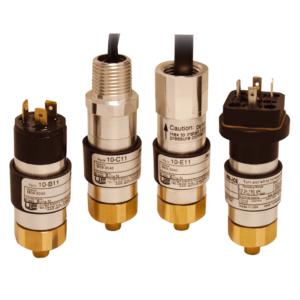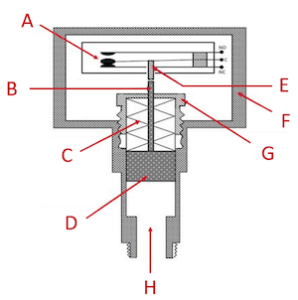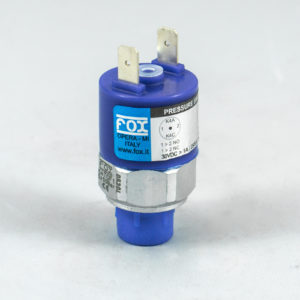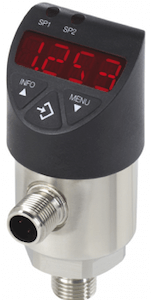A pressure switch is a type of industrial sensor that can detect a certain amount of pressure, and open or close an electrical contact. There are two main types of pressure switches; electrical pressure switches and mechanical pressure switches.
In this article, let’s discuss what pressure switches are, their construction and operation, applications and other characteristics.
What is a pressure switch?
A pressure switch is a special type of switch that can work with fluids or gasses. In its most elementary form, a pressure switch is capable of detecting a change in pressure. According to a predetermined/pre-set pressure level, these switches activate their electrical contacts to mimic the action of an actual switch.

Pressure switches are manufactured in three forms: electromechanical, solid-state and electronic pressure switches. While electronic and solid state pressure switches are the latest technologies, electromechanical type pressure switches have been in the industry since 1849.
As mentioned above, pressure switches are available for use with both glasses and liquids. The pressure switch type compatible with liquids is called ‘hydraulic pressure switch’. ‘Pneumatic pressure switches’ work with systems where compressed air is used.
How Pressure Switches Work
Pressure switches are available in a multitude of configurations. The simplest form of pressure switches is the SPDT type. SPDT stands for Single Pole, Double Throw type. The figure shown below indicates a cross section of a mechanical pressure switch.

The pressure switch shown here is housed in the housing (F), where the electrical contacts are shown in (A). It has two positions, Normally Open (NO) and Normally Close (NC). The opening at the bottom (H) is the inlet port where the pneumatic/hydraulic supply is connected to the switch. There is a piston (D) which is spring loaded, that can move upwards when there is sufficient pressure. The spring has a known spring constant which allows accurate determination of the activation pressure.
When the fluid/pneumatic pressure exceeds the threshold, the plunger is pushed upwards, which forces the operating pin (B) to exert force on the insulated trip button shown in E. This, in turn activates the switch, and switches the contact from NC position to NO position, closing the NO contacts.
To adjust the tripping force, the trip-setting nut (G) can be adjusted to increase or decrease the threshold. This allows setting the pressure level at which the micro switch switches between normally closed and normally open positions.
When discussing the switching thresholds, another factor called ‘hysteresis’ should also be mentioned. As well as when the switch activates due to an increase/decrease in pressure, it must return to its resting position when the pressure is decreased back again. If this switching/resetting point is a single value, the switch may tend to oscillate if the pressure is marginal.
To prevent this condition, a mechanical/electrical hysteresis has been introduced. This ensures that the switch activates at a certain threshold and maintains its position until pressure falls/increases below a certain value. This is often expressed as a percentage of the switch point value. For mechanical switches, this is not configurable and is often about 20%. Electronic pressure switches usually have a customizable hysteresis.
Pressure Switch Types
There are two main types of pressure switches, mechanical pressure switches and electronic pressure switches. Mechanical pressure switches are also known as electromechanical pressure switches.
Mechanical Pressure Switch
Mechanical pressure switches often consist of an electrical snap-action switch (clicking type) actuated using a mechanical sensing element. The mechanical assembly moves in response to changes in the system pressure; fluid or pneumatic.

Mechanical pressure switches are used to detect the presence or absence of fluid/air pressure in a system. One such application is the vehicle oil pressure sensor where an indicator is connected to show if there is any problem in the engine.
Upon reaching the switching threshold, mechanical pressure switches activate their electrical contacts and thus, signaling the pressure presence/absence .
There is also another type of mechanical/electromechanical pressure switches; differential pressure sensors.These sensors have two inlet ports in contrast to single inlet sensors. When the pressure available on the two sides are equal, the switch stays in a neutral position. When the pressure on one side increases, the piston moves towards the low pressure side and activates the switch.
There are few type of mechanical pressure switches, classified according to the technology being used:
- Diaphragm switches
- These switches use a welded metal diaphragm (sealed) that acts directly on the switch itself. These can function with pressures up to 10.43 bar and vacuum, but recommended to use at low rate cycles capped around 25 cycles per minute.
- Bourdon Tube switches
- Similar to diaphragm switches, these use a weld-sealed Bourdon tube to actuate the switch. These are also low cycle rate switches, but can handle upto around 1240 bar (124MPa) of pressure.
- Diaphragm piston switches
- These switches utilize an elastomeric diaphragm which is connected to a piston. The piston actuated the switch. Diaphragm piston switches work with pressures from vacuum to 110 psi (750kPa).
- These have a longer lifetime of 2.5 million average cycles.
- Piston switches
- Piston pressure switches have O-ring sealed pistons that directly act on the snap action switches.
- These have a longer lifetime of 2.5 million average cycles.
Electronic Pressure Switch
Electronic pressure switches were introduced in 1980 by Barksdale. These are also known as ‘solid state pressure switches’ or ‘digital pressure switches’ that have little to no mechanical parts. They are typically made of bonded strain gauge sensors coupled with triacs to mimic mechanical contacts.

Modern-day digital pressure switches have programmable switching points, adjustable hysteresis and analog/digital outputs to easily integrate with programmable logic controllers (PLCs). Electronic pressure switches can output analog signals (4-20mA) and digital signals. This allows the controllers to monitor not just pressure thresholds, but also monitor the pressure values in a system.
When compared with mechanical pressure switches, solid state pressure switches have a number of advantages which includes:
- Longer cycle life (~10 million cycles)
- Improved accuracy (0.5%)
- High shock/vibration resistance
- Long term stability
Pressure Switch Selection Criteria
To select a pressure switch that best suits a specific application, you need to consider multiple factors:
- Type of media
Not all sensors are compatible with all types of liquids/gases. For instance, Nitrile Butadiene Rubber (NBR) is best for air and hydraulic/machine oil while Ethylene Propylene Diene Monomer Rubber (EPDM) is suitable where water is the medium.
- Pressure
The pressure the sensor is subjected to should be one of the primary concerns when selecting a sensor.Diaphragm based sensors are suitable for vacuum and low pressure applications where piston-based designs are more suitable for high-pressure applications.
- Temperature Stablity
- Repeatability (Accuracy)
A sensor is as reliable as its repeatability. Being able to switch at the same threshold repeatedly is crucial for a pressure switch to secure its place in a specific application.
- Hysteresis
Simply explained as the difference between set point and reset point, hysteresis plays a major role in terms of the switching response of the switch. Too much hysteresis will cause the switch to stay latched up longer while a significantly lower hysteresis causes the switch to flip between on/off states frequently.
- Physical construction
Mechanical switches can be useful where less frequent detection/actuation is required. Electronic pressure switches are best suited for applications where fine control such as programmability, analog outputs and adjustability of pressure setpoints is required.
Pressure Switch Diagram
Most mechanical pressure switches are capable of handling high voltages such as 110V/220V AC. Therefore, a mechanical pressure switch can be directly connected with a load as shown in the figure below.
When the pressure switch is not activated, the normally closed output is connected to the red lamp. This lights up the red lamp. When a pressure is detected, the switch disconnects its normally closed output and connects the normally open output with the common terminal. This turns off the red lamp and turns on the green lamp.
For digital pressure switches such as the DP-M2A by Panasonic Automation Controls, the wiring can be done as shown in the figure below.

This sensor also provides an analog output, therefore, by connecting the white wire with a load ranging from 0-250 Ohms, the pressure reading also can be obtained by a PLC or a microcontroller.
Pressure Switch Price
Pressure switches are available in two categories as mentioned above. Between electronic and mechanical pressure switches, mechanical ones tend to be cheaper than electronic pressure switches. This is due to the less complexity in construction and the manufacturing process itself.
A general purpose mechanical pressure switch can cost from $10-20 to all the way up to a few hundreds of dollars.
Electronic pressure switches, on the other hand, are generally expensive due to their features, robustness and high reliability. Starting from around $100 for basic versions with less features, highly complex and sophisticated pressure switches such as Ashcroft DDS Pressure Switch can cost upto a few thousands of dollars.
What is a Low Pressure Switch?
Low pressure switches are connected to the lower pressure side of a system to detect suction pressure. These sensors detect negative pressure and trigger the switch.
Low pressure switches are mostly found in HVAC (Heating, Ventilation, Air Conditioning) systems to detect faults. In the event where the refrigerant in an air conditioning system escapes, it creates a low pressure inside the tubing. This can be detected by the low pressure sensors to effectively shut off the compressor clutch to disengage it.
These sensors are also used as an operation controller in cooling systems to regulate the temperature using a corresponding pressure setting. Low pressure switches are typically available in electromechanical variants, although electronic ones can also be programmed to function as low pressure detectors.
Pressure Switch Applications
Pressure switches find their applications in automotive, manufacturing and industrial environments. They are widely used in HVAC systems to detect faults and regulate temperature.
In pneumatic and hydraulic systems, pressure switches are used to regulate the pressure levels in safe and optimum range. For example, an air compressor has a resettable pressure switch which ensures that the compressor stops once the air pressure reaches the set value.
In the automotive industry, hydraulic pressure switches are used to detect oil pressure and engage safeties in engines.
In industrial furnaces, pressure switches are used to safely turn on/off the furnace by monitoring the air pressure inside.
Building management systems use well-pump pressure switches and pressure transducers to ensure that the water supply has sufficient pressure. For automatic water pressure regulation, pressure regulators are used in conjunction with electric water pumps. They activate the pump upon detection of drop in water pressure due to heavy usage.
Vacuum (negative pressure sensors) are used in boilers, air compressors and electric heaters to measure vacuum or low air pressure events in the mentioned systems.
What is the difference between Pressure Switch and Pressure Transmitter?
The term ‘pressure switch’ and ‘pressure transducer/pressure transmitter/pressure sensor’ are often misinterpreted in automation systems.
A pressure transducer (also known as a pressure transmitter or a pressure sensor) is also a device that is capable of measuring the pressure. However, pressure transmitters do not have a built-in switch to activate when a pressure threshold is reached. They can only convert the pressure measurement into electrical signals to represent the current pressure value. This can be a 4-20mA or 0-10V analog output, or a digital data stream.
The terms ‘transducer’, ‘transmitter’ and ‘sensor’ are often used interchangeably in the industry. Some call the digital output (where the sensor output is a data stream) type ‘pressure transmitters’ while the analog ones are called ‘transducers’.
Pressure switches, especially electronic ones have the same functionality as pressure transducers, but with an added feature of an electromechanical switch/contact to control a load by the sensor itself.
Conclusion
Pressure switches are often used as on/off switches to control electrical elements in a system by actively monitoring the fluid/air pressure in a system. In this article, we discussed pressure switches, their operating principles, applications and the difference between the pressure switches and transmitters. Although often overlooked, pressure switches play a major role in ensuring operational safety and process regulation in some critical applications.